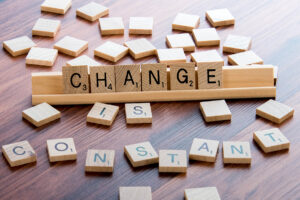 Changing our behavior is one on the hardest things we humans face. We are patterned creatures and we like the things with which we are comfortable. So much so that our brain will unconsciously push back on creating change. We especially avoid changing behaviors that are easy to do and that make us feel good for a little while, like sleeping in a little or overworking so we can avoid some of the more stressful things going on in our lives. To disengage for a bit each day we might drink a little too much alcohol or smoke some pot. We might even engage in an easy, creative and immediately fulfilling task like whipping up and wolfing down a batch of cookies every day.
Changing our behavior is one on the hardest things we humans face. We are patterned creatures and we like the things with which we are comfortable. So much so that our brain will unconsciously push back on creating change. We especially avoid changing behaviors that are easy to do and that make us feel good for a little while, like sleeping in a little or overworking so we can avoid some of the more stressful things going on in our lives. To disengage for a bit each day we might drink a little too much alcohol or smoke some pot. We might even engage in an easy, creative and immediately fulfilling task like whipping up and wolfing down a batch of cookies every day.
Why would you want to choose the difficult and uncomfortable solution over the easy, feel-good way out? Why would you want to change behaviors like these that are so easy and fulfilling in the moment and replace them with something else? What is the benefit on the other side of that for you? These are good questions, which must be answered if you want to create sustainable, positive change in your life. That’s why a good place to start in making these difficult changes easier to accomplish is to examine what is motivating you to make those changes—your purpose.
What Motivates You to Make Change?
In all things you want to achieve, you as a human are motivated extrinsically or intrinsically—either by outside forces or by those from within you. An example of extrinsic motivation is dieting and exercising to lose weight so that others find you attractive, or intentionally doing something to win yourself accolades from people for doing whatever that is.
 Extrinsically motivated action is doing something that makes you more acceptable to the outside world, and it is prolific. On the other hand, there is intrinsic motivation, which is harder to find because it is not commonly ingrained in us. Many people are not taught as children how to be internally motivated to proactively create positive change. Intrinsic motivation is all about doing something because it is internally satisfying to do it—it’s naturally rewarding because it aligns with our internal and authentic sense of self.
Extrinsically motivated action is doing something that makes you more acceptable to the outside world, and it is prolific. On the other hand, there is intrinsic motivation, which is harder to find because it is not commonly ingrained in us. Many people are not taught as children how to be internally motivated to proactively create positive change. Intrinsic motivation is all about doing something because it is internally satisfying to do it—it’s naturally rewarding because it aligns with our internal and authentic sense of self.
How do You Drive Positive Behavior Change?
True behavior change begins when you start looking inward to find that intrinsic motivation. A good way to begin that inner search is to intentionally notice the things you avoid, because what you avoid—such as discomfort or failure or the felt sense that you might let people down—can provide valuable data for making change. Then, consider what steps you are taking to ensure that you can continue to avoid doing the hard things that bring real positive change. When you look inward at those hard things, you begin to cultivate what truly matters—your purpose. When you are motivated intrinsically, you are working in favor of your overarching purpose, which makes choices and behavior change much easier.
I would like to share a simple exercise with you that I have learned for helping you to find your purpose. First, take a moment and write down a list of your three key motivators, that is, why you are doing the things you do. Right next to that list of three motivators, write down three desired outcomes: What are you seeking? Next to that list, create one that answers the question, “How does this serve me?”
|
Finding Your Purpose |
||
|
My Three Key Motivators |
My Three Desired Outcomes |
How Does This Serve Me? |
|
1. 2. 3. |
1. 2. 3. |
1. 2. 3. |
 The first time I made this list for myself, my third column was empty. These things did not serve me because I had not yet developed my purpose. I knew why I did them, and I knew what I wanted, but when I had to look inward as to whether they aligned with my personal integrity and values, I came up with nothing, and we are nothing without purpose. That was a startling experience for me two decades ago at the age of 21. Doing this exercise created an inception point for behavior change in my life. It changed my entire philosophy around how I live in my world.
The first time I made this list for myself, my third column was empty. These things did not serve me because I had not yet developed my purpose. I knew why I did them, and I knew what I wanted, but when I had to look inward as to whether they aligned with my personal integrity and values, I came up with nothing, and we are nothing without purpose. That was a startling experience for me two decades ago at the age of 21. Doing this exercise created an inception point for behavior change in my life. It changed my entire philosophy around how I live in my world.
From that point it took me years to get clear about who I was, and it is only through self-knowledge that we can proactively create positive change. There were a few core exercises I did that helped me gain a felt sense of “me” and invite in introspection without shame. That is important because shame gets in our way when we try to examine who we are. I also felt at the time that I didn’t live up to what I was supposed to be, so I stopped myself from trying, and that is no way to grow. A growth mindset means that we believe we are capable of anything, and that every challenge is an opportunity.
So, let’s take a moment and go deeper, doing some introspection to help you get to know yourself better and get closer to your intrinsic motivation. First, make a few quick notes about how you value yourself. What are three core elements that you bring to the world around you? What impact do you believe you have on the world? What are three things you need or feel fulfilled by in order to deliver those three elements that you wrote in the first line? What enables you to bring those things to the world? Finally, what does it mean about you when you accomplish each of the things you wrote in column 1? Does it mean you’re acceptable, lovable, worthy, valuable?
|
Finding Your Purpose 2 |
||
|
What Impacts do I Have on the World Around Me? |
What do I Need to Create These Impacts on the World? |
What does it Mean About Me When I Create These Impacts? |
|
1. 2. 3. |
1. 2. 3. |
1. 2. 3. |
I would like to invite you to take what you have written, and then watch the brief video just below titled, “A Self-Havening Guided Meditation for Making Change Easy by Finding Your Purpose.” If you have not yet completed these written exercises, start the video at the beginning to get a review of what you need to do to complete them. If you have completed them, you can start the video at 4:00 minutes to experience a deeper dive into determining your inner purpose.
Creating intrinsically motivated change is all about working in favor of your overarching purpose and aligning your goals with them. Once you determine your purpose, building new, more preferable behaviors is much easier to achieve!
When your goals align with your purpose, making change is so much easier! In this video Dr. Kate walks you through a therapeutic exercise and guided meditation to help you deepen your awareness of your inner purpose to help make building new behaviors (and releasing the old!) much easier. We recommend having a piece of paper and a writing instrument available to full benefit from this guided meditation.
A recent study examining the presence of “Purpose,” as “defined by the tendency to derive meaning from life’s experiences and possess a sense of intentionality and goal directedness that guides behavior,” found elderly individuals who scored high on a scale measuring purpose had significantly greater levels of cognitive aptitude later in life as well as lower rates of disability and even death. Purpose is Life! Let’s find your purpose and make long-term sustainable change.
Humans are patterned creatures and we love easy patterns (and easy buttons!). This can make behavior change and creating new healthy patterns even harder. In this video Dr. Kate supports us in exploring the differences between extrinsic and intrinsic motivation in order to empower our ability to successfully create positive change.
In this video Dr. Kate walks us through an exercise to examine if we are extrinsically or intrinsically motivated by examining our motivations, desired outcomes, and finally, how these experiences ultimately align with our true purpose. When we have intrinsic motivation we are working in favor of our overarching purpose which makes choices and behavior change much easier!
Let’s make healthy change as easy as we can. It’s time to get internally motivated!
It’s 2021 and we are all yearning for change this year. Living in the chronic stress of 2020 has led to many of us leaning on less-than-preferable coping skills to manage our emotions. This video focuses on creating compassionate awareness and proactive positive opportunities to release any patterns that have developed in the past while creating new, healthy, behaviors for the future.
Join Dr. Kate in this guided meditation to welcome in Mindful Touch and Self-Havening along with neuroplasticity to create empowered change.
In this video Dr. Kate invites us to assess our current coping skills with openness and curiosity. How are you doing these days? Are you feeling the feels? Or numbing out? Are you in relationship with your mind and body? Are you doing a little more eating these days? Drinking? Smoking? Working?
Do you have self-compassion for the choices you’re making these days in order to support your system to disconnect from the difficult moments? Uncertainty, stress, and worry are abundant right now. Our mind, and especially our dear friend Amy the Amygdala, will consistently do whatever it can to reduce the experience of pain. Relying more heavily on external methods of coping—substances, food, overworking, sleeping, and more—is common.
It’s easy to pull away from the hard stuff and avoid feeling the hard things. We are biologically hardwired to avoid pain and enjoy pleasure even when pleasure has long-term consequences. Let’s get lovingly curious about our choices and explore if what we’re doing in the “now” aligns with what we want for the future.
In this video Dr. Kate provides quick tips on how to find the core driving thoughts tied to the less-than-preferable choices we are making. Let’s find the core neural network that our brain is connecting to in a moment of avoidance – “I am…..”
When you…
Take the drink…
Smoke the cigarette…
Work compulsively…
Overeat…
How do you feel about who you are and what you’re needing in the moment?
“I am overwhelmed?” “I can relax now?” “I am successful?” “I am outgoing?” “I am numb?”
These core beliefs tied our behaviors are powerful indicators of what our brain and body are seeking relief from and/or wanting to generate more of. Notice that they can be both positive and negative. Understanding the underlying thoughts of our behaviors is crucial to creating new decision trees and associative learning to empower a new way of being.






